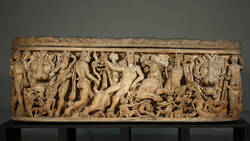What a hustle and bustle there is on all sides of the sarcophagus: the god of wine Dionysus and his dissolutely voluptuous companions populate the surrounding reliefs. Maenads, satyrs and panes are dancing and making music, acting enthusiastic and full of love.
The shape of the sarcophagus and the two lion protomes are reminiscent of vats used as winepresses. The intoxicating mood and the "most powerful urge to live" ( Arthur Schopenhauer ) are thus indicated not only figuratively but also formally.
Further Media





To our eyes it may seem odd to have a funerary relief with no sign of sadness or mourning – and instead show scenes dedicated to life’s pleasures and excesses. But for the Romans, the commemoration of the dead was a far more joyful affair than in many Christian religions. The relatives would gather at the graves where, rather like on a picnic, they ate and drank. In the presence of death, they celebrated life – and of course, for that, Dionysus and his entourage offered the perfect inspiration. The message: Celebrate now, carpe diem – enjoy the moment – and don’t think of tomorrow!
Incidentally, our sarcophagus is far from being an eccentric singular work. Quite the contrary – it was a very popular topic, and we know of at least nearly 450 examples of Roman sarcophagi decorated with a Dionysian celebration.
Let’s take a moment to look at Dionysus’s entourage. First of all, there are the maenads, the women accompanying the god and, in their veneration of him, falling into an ecstatic frenzy. On the far right, one of them has even failed to notice her clothes slipping off her. The entourage also includes satyrs, shown here as naked youths with panther skins over their shoulders – for instance, to the left of Dionysus, the figure holding up the tiger’s tail. And then there are Pan figures, the god of shepherds, with horns, a goatee and the hindquarters of a goat. An especially large figure of Pan is on the right of the tiger, while a smaller Pan at the bottom right is copulating with a goat. Pan was renowned for amusing himself on quiet afternoons by suddenly scaring animals, causing them to stampede – the origin of the word ‘panic’.
In the museum, the sarcophagus is ideally lit. But in a burial chamber lit solely by the flickering flames of a torch, you can easily imagine the figures looked almost alive.
- Location & Dating
- c. 220/40 CE
- Material & Technique
- Marble from the Greek islands
- Dimenions
- H: 63,0 cm, B: 173,0 cm, T: 64,0 cm Gewicht: 635,0 kg H. ohne Deckel: 51-54 cm
- Museum
- Skulpturensammlung
- Inventory number
- Hm 271